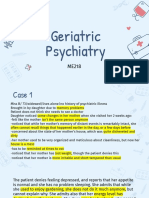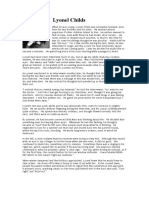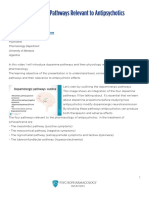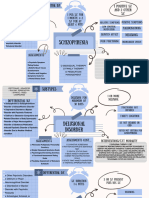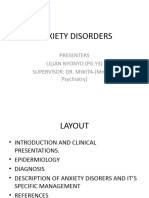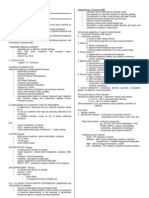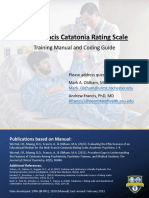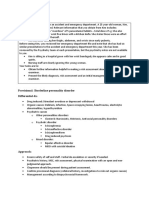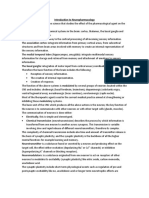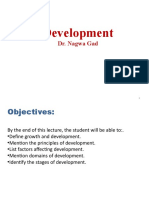0 ratings0% found this document useful (0 votes)
141 views2 - Diagnosis & Classification in Psychiatry
2 - Diagnosis & Classification in Psychiatry
Uploaded by
Kholoud KholoudThis document discusses diagnosis and classification in psychiatry. It defines mental disorders and distinguishes them from normal experiences. It describes the importance of diagnosis for communication, comprehension, and research. Organizing principles of classifications include the organic vs functional distinction and features of psychosis vs neurosis. Current official classifications are the ICD-10 and DSM-5. Challenges in psychiatric classification include its subjective nature and lack of objective criteria. Etiology in psychiatry is complex and multifactorial, involving genetic, biological, psychological, social, and other factors. Cultural beliefs around concepts like evil eye and possession are discussed.
Copyright:
© All Rights Reserved
Available Formats
Download as PPTX, PDF, TXT or read online from Scribd
2 - Diagnosis & Classification in Psychiatry
2 - Diagnosis & Classification in Psychiatry
Uploaded by
Kholoud Kholoud0 ratings0% found this document useful (0 votes)
141 views22 pagesThis document discusses diagnosis and classification in psychiatry. It defines mental disorders and distinguishes them from normal experiences. It describes the importance of diagnosis for communication, comprehension, and research. Organizing principles of classifications include the organic vs functional distinction and features of psychosis vs neurosis. Current official classifications are the ICD-10 and DSM-5. Challenges in psychiatric classification include its subjective nature and lack of objective criteria. Etiology in psychiatry is complex and multifactorial, involving genetic, biological, psychological, social, and other factors. Cultural beliefs around concepts like evil eye and possession are discussed.
Original Title
2- Diagnosis & Classification in Psychiatry.pptx
Copyright
© © All Rights Reserved
Available Formats
PPTX, PDF, TXT or read online from Scribd
Share this document
Did you find this document useful?
Is this content inappropriate?
This document discusses diagnosis and classification in psychiatry. It defines mental disorders and distinguishes them from normal experiences. It describes the importance of diagnosis for communication, comprehension, and research. Organizing principles of classifications include the organic vs functional distinction and features of psychosis vs neurosis. Current official classifications are the ICD-10 and DSM-5. Challenges in psychiatric classification include its subjective nature and lack of objective criteria. Etiology in psychiatry is complex and multifactorial, involving genetic, biological, psychological, social, and other factors. Cultural beliefs around concepts like evil eye and possession are discussed.
Copyright:
© All Rights Reserved
Available Formats
Download as PPTX, PDF, TXT or read online from Scribd
Download as pptx, pdf, or txt
0 ratings0% found this document useful (0 votes)
141 views22 pages2 - Diagnosis & Classification in Psychiatry
2 - Diagnosis & Classification in Psychiatry
Uploaded by
Kholoud KholoudThis document discusses diagnosis and classification in psychiatry. It defines mental disorders and distinguishes them from normal experiences. It describes the importance of diagnosis for communication, comprehension, and research. Organizing principles of classifications include the organic vs functional distinction and features of psychosis vs neurosis. Current official classifications are the ICD-10 and DSM-5. Challenges in psychiatric classification include its subjective nature and lack of objective criteria. Etiology in psychiatry is complex and multifactorial, involving genetic, biological, psychological, social, and other factors. Cultural beliefs around concepts like evil eye and possession are discussed.
Copyright:
© All Rights Reserved
Available Formats
Download as PPTX, PDF, TXT or read online from Scribd
Download as pptx, pdf, or txt
You are on page 1of 22
At a glance
Powered by AI
The key takeaways are that psychiatry aims to distinguish normal from abnormal psychological experiences and define mental disorders. A mental disorder involves significant distress or disability and is not just a normal response to stressors.
Contemporary psychiatric classifications distinguish between organic disorders with identifiable brain pathology and functional disorders without obvious pathology. However, sophisticated techniques have revealed underlying neuropathology in some disorders previously considered functional.
The main causative factors considered in psychiatry are genetic, neuropathological, endocrinological, pharmacological, social, and psychological factors. Psychiatric disorders often involve multiple causative factors.
Diagnosis & Classification in
Psychiatry
Dr. Waddah Alalmaei
Psychiatry & Normality
• How To Distinguish normal psychological
experience & abnormal one ?
Definition
A mental disorder is a syndrome characterized by
clinically significant disturbance in an individual’s
cognition, emotion regulation, or behavior that
reflects a dysfunction in the psychological,
biological, or developmental processes underlying
mental functioning.
• Mental disorders are usually associated with
significant distress or disability in social, occupational,
or other important activities.
• An expectable or culturally approved response to a
common stressor or loss, such as the death of a loved
one, is not a mental disorder.
• Socially deviant behavior (e.g., political, religious, or
sexual) and conflicts that are primarily between the
individual and society are not mental disorders unless
the deviance or conflict results from a dysfunction in
the individual, as described above.
Importance Of Diagnosis
Communication
Comperhension
Research
Organizing principles of contemporary
classifications
• Organic and functional
– Organic disorders are disorders with structural brain
pathology that can be detected by clinical assessment or
usual tests. E.g. delirium, dementia, substance-induced
mental disorders, and medication-induced mental disorders.
– Functional disorders are psychiatric disorders without obvious
structural brain pathology. E.g. Schizophrenia, mood
disorders, anxiety disorders, adjustment disorders
– This distinction between organic and functional has begun to
appear less helpful now, because sophisticated modem
techniques of investigation have revealed underlying
neuropathology in some disorders previously considered
functional.
Features Suggestive of Organic Mental
Disorders (CNS pathology)
• Disturbed consciousness +/- other cognitive
disturbance in: attention, concentration,
orientation or memory.
• Physical illness (e.g. diabetes, hypertension).
• Vital signs disturbances (e.g. fever, high BP).
• Neurological features (e.g. ataxia, dysarthria).
• Neurosis and psychosis
– In modern usage, the term psychosis refer broadly to sever
psychiatric disorders.
– Lack of insight is often suggested criterion for psychosis.
– Inability to distinguish between subjective experience and
external reality is somewhat more straightforward criterion
for psychosis.
– Neurosis Generally less severe forms of psychiatry
disorders in which the patient is able to distinguish
between subjective experience and reality. No lack of
insight, delusions or hallucinations
psychosis neurosis
Mental disorders in which the patient lacks Generally less severe forms of psychiatry
insight and is unable to distinguish between disorders in which the patient is able to
subjective experience and external reality, as distinguish between subjective experience
evidenced by disturbances in thinking and external reality.
(delusions), perception (hallucinations), or
behavior (e.g. violence). No lack of insight, delusions or
hallucinations.
Examples: schizophrenia, severe mood
disorders, delusional disorders. It can be due Examples: dysthymic disorder, anxiety, panic
to an organic cause (organic psychosis) e.g. & phobic disorders.
delirium, dementia, substance abuse, head
injury. Features are abnormal in quantity (e.g.
excessive fear and avoidance).
Features are abnormal in quality (e.g.
delusions, hallucinations).
current diagnoses are primarily syndrome based.
They rely heavily on clinical observations that signs
and symptoms co-occur in groups of patients and
also that they have a characteristic course and
response to treatment.
syndromes: collections of symptoms that tend to co-
occur and appear to have a characteristic course and
outcome
Current & Official psychiatric
classifications
• ICD-10
– was endorsed by the Forty-third World Health Assembly
in May 1990 and came into use in WHO Member States as
from 1994. The 11th revision of the classification has
already started and will continue until 2017.
– The International Classification of Diseases (ICD) is an
international standard diagnostic classification for a wide
variety of health conditions. Chapter V focuses on "mental
and behavioural disorders" and consists of 10 main groups
ICD- 10
• F0: Organic, including symptomatic, mental disorders
• F1: Mental and behavioural disorders due to use of psychoactive substances
• F2: Schizophrenia, schizotypal and delusional disorders
• F3: Mood [affective] disorders
• F4: Neurotic, stress-related and somatoform disorders
• F5: Behavioural syndromes associated with physiological disturbances and physical
factors
• F6: Disorders of personality and behaviour in adult persons
• F7: Mental retardation
• F8: Disorders of psychological development
• F9: Behavioural and emotional disorders with onset usually occurring in childhood
and adolescence
• In addition, a group of "unspecified mental disorders".
DSM-5
Classification (May
2013) is an
evidence-based
manual useful in
accurately and
consistently
diagnose mental
disorders
PROBLEMS in CLASSIFYING PSYCHIATRIC
DISORDERS
• Psychiatry, in contrast to other branches of medicine, relies
on the patient's own subjective report of symptoms and the
doctor's observation of patient behavior to arrive at a
diagnosis.
• Psychiatry lacks objective and independent criteria for
sorting out psychiatric disorders.
• Psychiatric disorders are manifested by a quantitative
deviation in behavior, ideation and emotion from a
normative concept and it is difficult to define normal human
behavior.
• Psychiatric symptoms are highly nonspecific and quite
unstable over time.
Etiology in Psychiatry
The Complexity of etiology in Psychiatry
1. Time factor: causes are often remote in time from
the effect they produce.
2. Single cause may lead to several psychological effects
e.g. deprivation from parental affection may lead to
depression or conduct disorder in children and
adolescents.
3. Single effect may arise from several causes e.g.
depression may be due to accumulation of several
causes like endocrinopathies, psychosocial stresses
and side effects of some drugs.
4. Most psychiatric disorders are multifactorial.
Effect Predisposing Precipitating Aggravating Maintaining
Nature
E.g. Genetic E.g. First dose E.g. Further E.g. Continuation
Bio predisposition of cannabis abuse of cannabis abuse
e.g. panic abuse
disorder
E.g. Abnormal E.g. Sudden or E.g. Further E.g. Continuation
psycho- personally severe psychological of such stresses
traits with poor psychological stresses
stress stress
adaptation
E.g. Parental Marriage E.g. Marital E.g. continuation
social separation conflict of marital
problems
Main causative factors in psychiatry:
A. Genetic : e.g. in schizophrenia , mood disorders , panic
disorder and agoraphobia.
B. Neuropathological: e.g. dementias ,delirium.
C. Endocrinopathological: e.g. hyperthyroidism /
hypothyroidism.
D. Pharmacological: side effects of medications e.g. steroids >
mood changes.
E. Social: e.g. marital discord /occupational problems/financial
difficulties.
F. Psychological : behavioral ,cognitive , or psychodynamic
problems (subconscious processes that
Psychiatry & Cultural beliefs
Evil Eye , Possession ,Witchcraft
?????
النظرة االجتماعية ال تمثل الشرع
تماما ) ( ال تطابق تماما و ال تخالف
مبالغة وتعميم وقلة علم بالشرع وبالطب
تجاوزات شرعية وأخالقية وطبية
تأثير العين والمس والسحر على صحة البشر ثابت
أما الكيفية والعالمات لكل منها فلم ترد بالتحديد
الرقية الشرعية لالستشفاء ال لتشخيص األمراض وأسبابها
اآلثار السلبية لألفكار المجتمعية الخاطئة
● حرمان المرضى من العالج الطبي السليم
● التدخل في التشخيص والجزم بناء على خبرات شخصية
● التدخل في طريقة التداوي دون مسئولية
● إيذاء المرضى بالضرب والكهرباء وغيرها
You might also like
- DSM 5 - DSM 5Document7 pagesDSM 5 - DSM 5Roxana ClsNo ratings yet
- Testing Strategies: Hurst Review Services 240Document3 pagesTesting Strategies: Hurst Review Services 240reynold100% (1)
- DSM 5 Clinical Cases NotesDocument1 pageDSM 5 Clinical Cases Notestim clayNo ratings yet
- Geriatric Psychiatry Group CDocument77 pagesGeriatric Psychiatry Group Cchew weijianNo ratings yet
- Yale Brown Obsessive Compulsive ScaleDocument7 pagesYale Brown Obsessive Compulsive ScaleVidhya SriNo ratings yet
- Introduction To PsychiatryDocument15 pagesIntroduction To PsychiatryKulgaurav RegmiNo ratings yet
- Challenging Behaviours (Power Point)Document17 pagesChallenging Behaviours (Power Point)tamNo ratings yet
- Somatic Symptom Disorder DSM-5 300.82 (F45.1) - TherapediaDocument3 pagesSomatic Symptom Disorder DSM-5 300.82 (F45.1) - TherapediaNahzatul FatmaNo ratings yet
- Etiopathogenesis of DeliriumDocument36 pagesEtiopathogenesis of DeliriumAarti Gupta100% (1)
- BTB Template Er-IntakeDocument3 pagesBTB Template Er-IntakeBoy MadNo ratings yet
- Past MCQs On Ocular AnatomyDocument7 pagesPast MCQs On Ocular AnatomyEliza Spark56% (9)
- Physiology PF PuerperiumDocument34 pagesPhysiology PF PuerperiumKholoud Kholoud100% (5)
- Past MCQs On Ocular AnatomyDocument7 pagesPast MCQs On Ocular AnatomyEliza Spark56% (9)
- 426 C1 MCQ'sDocument5 pages426 C1 MCQ'sKholoud Kholoud100% (1)
- Case Study: Lyonel ChildsDocument11 pagesCase Study: Lyonel ChildsVaneSsaNo ratings yet
- By Richard Pinson, MD, FACP: Clinicians Often Struggle With The Distinction Between Delirium and EncephalopathyDocument10 pagesBy Richard Pinson, MD, FACP: Clinicians Often Struggle With The Distinction Between Delirium and EncephalopathynoraNo ratings yet
- PsychopathologyDocument24 pagesPsychopathologyamulya anandNo ratings yet
- Psych Ch. 7 Notes (Tutor)Document5 pagesPsych Ch. 7 Notes (Tutor)Haylle ThomasNo ratings yet
- Psychiatry DiagnosisDocument4 pagesPsychiatry DiagnosisdrqubitNo ratings yet
- Dopamine Pathways PDFDocument3 pagesDopamine Pathways PDFMuhammad Zul Fahmi AkbarNo ratings yet
- Schizophrenia Spectrumand Other Psychotic Disorders MINDMAPSDocument5 pagesSchizophrenia Spectrumand Other Psychotic Disorders MINDMAPSecheers.csflNo ratings yet
- Malingering NbiDocument5 pagesMalingering NbiPridina SyadirahNo ratings yet
- Psychopharmacology in Medically Ill PatientsDocument21 pagesPsychopharmacology in Medically Ill PatientsAklile TsegaNo ratings yet
- Anxiety DisorderDocument34 pagesAnxiety DisorderDr. Aron Kipaka, MDNo ratings yet
- Off-Label Trazodone Prescription-Evidence, Benefits and RisksDocument9 pagesOff-Label Trazodone Prescription-Evidence, Benefits and RisksomarapesNo ratings yet
- Psychiatry Notes For PGDocument8 pagesPsychiatry Notes For PGskycall28100% (1)
- List of Books: S.N Author Title Publication ISBN QTY RemarkDocument2 pagesList of Books: S.N Author Title Publication ISBN QTY RemarkTemesgen EndalewNo ratings yet
- Drugs Used To Treat Bipolar Disorder: By: DR Satar OstadhadiDocument31 pagesDrugs Used To Treat Bipolar Disorder: By: DR Satar OstadhadiSattar OstadhadiNo ratings yet
- Lab TestsDocument1 pageLab TestsnkivcNo ratings yet
- PA 644 - M2 LecturesDocument735 pagesPA 644 - M2 LectureskatNo ratings yet
- Alcohol Use Disorder MGMT Guideline - Final... EstDocument83 pagesAlcohol Use Disorder MGMT Guideline - Final... EstMuluken TesfayeNo ratings yet
- PA 644 - M2 LecturesDocument412 pagesPA 644 - M2 LectureskatNo ratings yet
- PsychopharmacologyDocument53 pagesPsychopharmacologypujarze4100% (1)
- Adhd Toolkit MedicationsDocument1 pageAdhd Toolkit MedicationsreneezNo ratings yet
- Psychopharmacology: Rainier B. Umali, M.DDocument198 pagesPsychopharmacology: Rainier B. Umali, M.DIS99057No ratings yet
- Dr. Jagdeo Survival ManualDocument16 pagesDr. Jagdeo Survival ManualAli BabaNo ratings yet
- Psychopharmacology 1Document7 pagesPsychopharmacology 1RajP01No ratings yet
- Shortened REM Latency and Increased REM: Previous AttemptDocument19 pagesShortened REM Latency and Increased REM: Previous AttemptActeen MyoseenNo ratings yet
- Initial Hospital Visit Inpatient Consult NoteDocument6 pagesInitial Hospital Visit Inpatient Consult NoteJanu easwarNo ratings yet
- Antipsychotics For SchizophreniaDocument33 pagesAntipsychotics For Schizophreniapsychopharmacology100% (4)
- Psychotropic-Induced Hyponatremia: A ReviewDocument9 pagesPsychotropic-Induced Hyponatremia: A ReviewJAVED ATHER SIDDIQUINo ratings yet
- Psychopharmacology NotesDocument33 pagesPsychopharmacology NotesIshita Verma100% (1)
- Antidepressants Comparison Guide Most Commonly Prescribed: Recommend GenericsDocument3 pagesAntidepressants Comparison Guide Most Commonly Prescribed: Recommend GenericsCarina ColtuneacNo ratings yet
- SUD I - Opioid-Related Disorders Cheat Sheet: by ViaDocument4 pagesSUD I - Opioid-Related Disorders Cheat Sheet: by ViaThư Phạm100% (1)
- Antipsychotics Guidelines PDFDocument31 pagesAntipsychotics Guidelines PDFZulvikar Umasangadji100% (1)
- Differential Diagnosis of 2018Document8 pagesDifferential Diagnosis of 2018Dhino Armand Quispe SánchezNo ratings yet
- Week 2 (OSCE CASC Book II 2018-19) 03.09.2018Document48 pagesWeek 2 (OSCE CASC Book II 2018-19) 03.09.2018Andrew WdsmithNo ratings yet
- 2021.01 Newer AntipsychoticsDocument42 pages2021.01 Newer AntipsychoticsHassan IbrahimNo ratings yet
- A Pa Suicide Guidelines Review ArticleDocument8 pagesA Pa Suicide Guidelines Review Articlenikko268No ratings yet
- Anxiety/Depression: S AlprazolamDocument2 pagesAnxiety/Depression: S Alprazolamleesa100% (1)
- Antidepressant AgentsDocument38 pagesAntidepressant AgentsdidiNo ratings yet
- AnxietyDocument4 pagesAnxietyIT’S ME HAYLANo ratings yet
- NR546 Psychopharm Midterm Exam Questions and Answers Latest 2021Document11 pagesNR546 Psychopharm Midterm Exam Questions and Answers Latest 2021iannyaga450No ratings yet
- Psychdrugforpeds PDFDocument22 pagesPsychdrugforpeds PDFAnna HungNo ratings yet
- Bush-Francis Catatonia Rating ScaleDocument31 pagesBush-Francis Catatonia Rating ScaletamaraNo ratings yet
- Symptom Overreporting and Dissociative Experiences: A Qualitative ReviewDocument13 pagesSymptom Overreporting and Dissociative Experiences: A Qualitative ReviewKamiNo ratings yet
- Consultation-Liaison Psychiatry (Psychosomatic Medicine) : M.Zainie Hassan A.RDocument25 pagesConsultation-Liaison Psychiatry (Psychosomatic Medicine) : M.Zainie Hassan A.RDavi DzikirianNo ratings yet
- A Basic Approach To A Patient With A Psychiatric Problem - Jullian Nasti FinalDocument3 pagesA Basic Approach To A Patient With A Psychiatric Problem - Jullian Nasti FinaltnsourceNo ratings yet
- Major Theories of Psychiatry (Summer)Document26 pagesMajor Theories of Psychiatry (Summer)dave del rosarioNo ratings yet
- DSM 5 Clinical Cases - Schizophrenia and Other Psychotic DisordersDocument20 pagesDSM 5 Clinical Cases - Schizophrenia and Other Psychotic DisordersAlexandra MurdyNo ratings yet
- Varun Kumar, 2017 - Getting Started in PsychiatryDocument148 pagesVarun Kumar, 2017 - Getting Started in PsychiatryBernard FZ100% (1)
- Psychiatry Grand NotesDocument10 pagesPsychiatry Grand NotesNathan T. CheungNo ratings yet
- B2B Psychopharmacology 2015Document128 pagesB2B Psychopharmacology 2015Soleil DaddouNo ratings yet
- Provisional: Borderline Personality Disorder Differential DXDocument6 pagesProvisional: Borderline Personality Disorder Differential DXhernandez2812No ratings yet
- History of PsychopharmacologyDocument28 pagesHistory of PsychopharmacologyclauffaledioNo ratings yet
- PPDGJ 3 PDFDocument279 pagesPPDGJ 3 PDFtri ummiNo ratings yet
- INTRODUCTION TO NEUROPHARMACOLOGYyyDocument27 pagesINTRODUCTION TO NEUROPHARMACOLOGYyyEbad RazviNo ratings yet
- Introduction To NeuropharmacologyDocument6 pagesIntroduction To Neuropharmacologyammarhafez78100% (1)
- Ethical Issues in Clinical Forensic PsychiatryFrom EverandEthical Issues in Clinical Forensic PsychiatryArtemis IgoumenouNo ratings yet
- Seizure: Sudden Abnormal Brain ActivityDocument8 pagesSeizure: Sudden Abnormal Brain ActivityKholoud KholoudNo ratings yet
- 17 AnemiaDocument8 pages17 AnemiaKholoud KholoudNo ratings yet
- Res Distress in Neonate: Hyaline Membrane DiseaseDocument3 pagesRes Distress in Neonate: Hyaline Membrane DiseaseKholoud KholoudNo ratings yet
- Development: Dr. Nagwa GadDocument37 pagesDevelopment: Dr. Nagwa GadKholoud KholoudNo ratings yet
- 5 - Antenatal CareDocument25 pages5 - Antenatal CareKholoud KholoudNo ratings yet
- 20-Short Stature SDLDocument11 pages20-Short Stature SDLKholoud KholoudNo ratings yet
- Ethical Issues in Obstetrics and GynecologyDocument17 pagesEthical Issues in Obstetrics and GynecologyKholoud KholoudNo ratings yet
- History Pedia Edition @RAYYAN.T: Personal DataDocument5 pagesHistory Pedia Edition @RAYYAN.T: Personal DataKholoud KholoudNo ratings yet
- 2 - Applied AnatomyDocument46 pages2 - Applied AnatomyKholoud KholoudNo ratings yet
- Labour and Delivery: Dr. Amani ShamanDocument56 pagesLabour and Delivery: Dr. Amani ShamanKholoud KholoudNo ratings yet
- 3 - Puerperium and LactationDocument29 pages3 - Puerperium and LactationKholoud KholoudNo ratings yet
- SMLE, 14th - 24th of OctoberDocument89 pagesSMLE, 14th - 24th of OctoberKholoud KholoudNo ratings yet
- 1 - Maternal Physiological Changes During PregnancyDocument45 pages1 - Maternal Physiological Changes During PregnancyKholoud KholoudNo ratings yet
- Breast DisDocument17 pagesBreast DisKholoud KholoudNo ratings yet
- Potassium Final2Document18 pagesPotassium Final2Kholoud KholoudNo ratings yet
- Dissociative DisordersDocument25 pagesDissociative DisordersKholoud KholoudNo ratings yet
- Disruptive, Impulse-Control, and Conduct DisordersDocument18 pagesDisruptive, Impulse-Control, and Conduct DisordersKholoud KholoudNo ratings yet
- Ethical Issues in Obstetrics and GynecologyDocument17 pagesEthical Issues in Obstetrics and GynecologyKholoud KholoudNo ratings yet
- ) 1 Student Evaluation (Form: Knowledge and Academic ActivityDocument2 pages) 1 Student Evaluation (Form: Knowledge and Academic ActivityKholoud KholoudNo ratings yet
- 2-Lab Med 2015 Lip PM HPA Final ExamDocument3 pages2-Lab Med 2015 Lip PM HPA Final ExamKholoud KholoudNo ratings yet
- NCM112 Acid Base DisordersDocument7 pagesNCM112 Acid Base DisordersRalph Elvin MacanlalayNo ratings yet
- DAFTAR PUSTAKA Lapkas InternaDocument3 pagesDAFTAR PUSTAKA Lapkas InternadeltaNo ratings yet
- Guide To Mental HealthDocument4 pagesGuide To Mental HealthKamaAfandiyevaNo ratings yet
- Trastornos Somatoformes y Disociativos PDFDocument28 pagesTrastornos Somatoformes y Disociativos PDFkaren Daniela Puma FarinangoNo ratings yet
- Skisofrenia: DR Dickson Legoh, SPKJDocument45 pagesSkisofrenia: DR Dickson Legoh, SPKJVeraNo ratings yet
- Weight Gain - Unintentional - MedlinePlus Medical EncyclopediaDocument3 pagesWeight Gain - Unintentional - MedlinePlus Medical EncyclopediaMustafa AlmasoudiNo ratings yet
- (Corrected) Cardiac Monitoring and DefibrillatorDocument28 pages(Corrected) Cardiac Monitoring and DefibrillatorConrad DaabuNo ratings yet
- Ataxia: Dr. Vipinnath E.N. (PT)Document18 pagesAtaxia: Dr. Vipinnath E.N. (PT)AKHILNo ratings yet
- Abilify Dosing GuideDocument2 pagesAbilify Dosing GuidemtassyNo ratings yet
- Movement Disorders BabcockDocument19 pagesMovement Disorders BabcockBaiq Trisna SatrianaNo ratings yet
- Psych 17 Somatic - Cognitive Disorders DEAN Algo ApostolDocument11 pagesPsych 17 Somatic - Cognitive Disorders DEAN Algo ApostolLaurisse April NecesitoNo ratings yet
- AphasiaDocument13 pagesAphasiaaamirNo ratings yet
- AtaxiaDocument10 pagesAtaxiaosakaNo ratings yet
- Inclusion and Exclusion CriteriaDocument26 pagesInclusion and Exclusion CriteriaScribdTranslationsNo ratings yet
- Priyanaka ResumeDocument3 pagesPriyanaka ResumeOmprakash SahuNo ratings yet
- UPPER RESPIRATORY TRACT INFECTIONS QuizletDocument3 pagesUPPER RESPIRATORY TRACT INFECTIONS QuizletKatriona IntingNo ratings yet
- ParQ Plus Jan 2023 Fillable 1 Copy 1Document4 pagesParQ Plus Jan 2023 Fillable 1 Copy 1marlon.castillo005No ratings yet
- ALPORAZAMDocument2 pagesALPORAZAMAdrian Martinez OdascoNo ratings yet
- Psychology Case Study Grade 12Document5 pagesPsychology Case Study Grade 12Ritika100% (2)
- Feeding and Eating Disorders in DSM 5Document3 pagesFeeding and Eating Disorders in DSM 5zoyachaudharycollegeNo ratings yet
- Mental Illness BeetowenDocument4 pagesMental Illness BeetowenTalmaciu AmyNo ratings yet
- Full Download Interpersonal psychotherapy for posttraumatic stress disorder 1st Edition Markowitz PDF DOCXDocument62 pagesFull Download Interpersonal psychotherapy for posttraumatic stress disorder 1st Edition Markowitz PDF DOCXmysonyanum100% (3)
- First Page PDFDocument1 pageFirst Page PDFKapil NirolaNo ratings yet
- Suicide PreventionDocument49 pagesSuicide Preventionmary grace banaNo ratings yet
- Quiz - NeurologicalDocument3 pagesQuiz - NeurologicalRebekah HNo ratings yet



